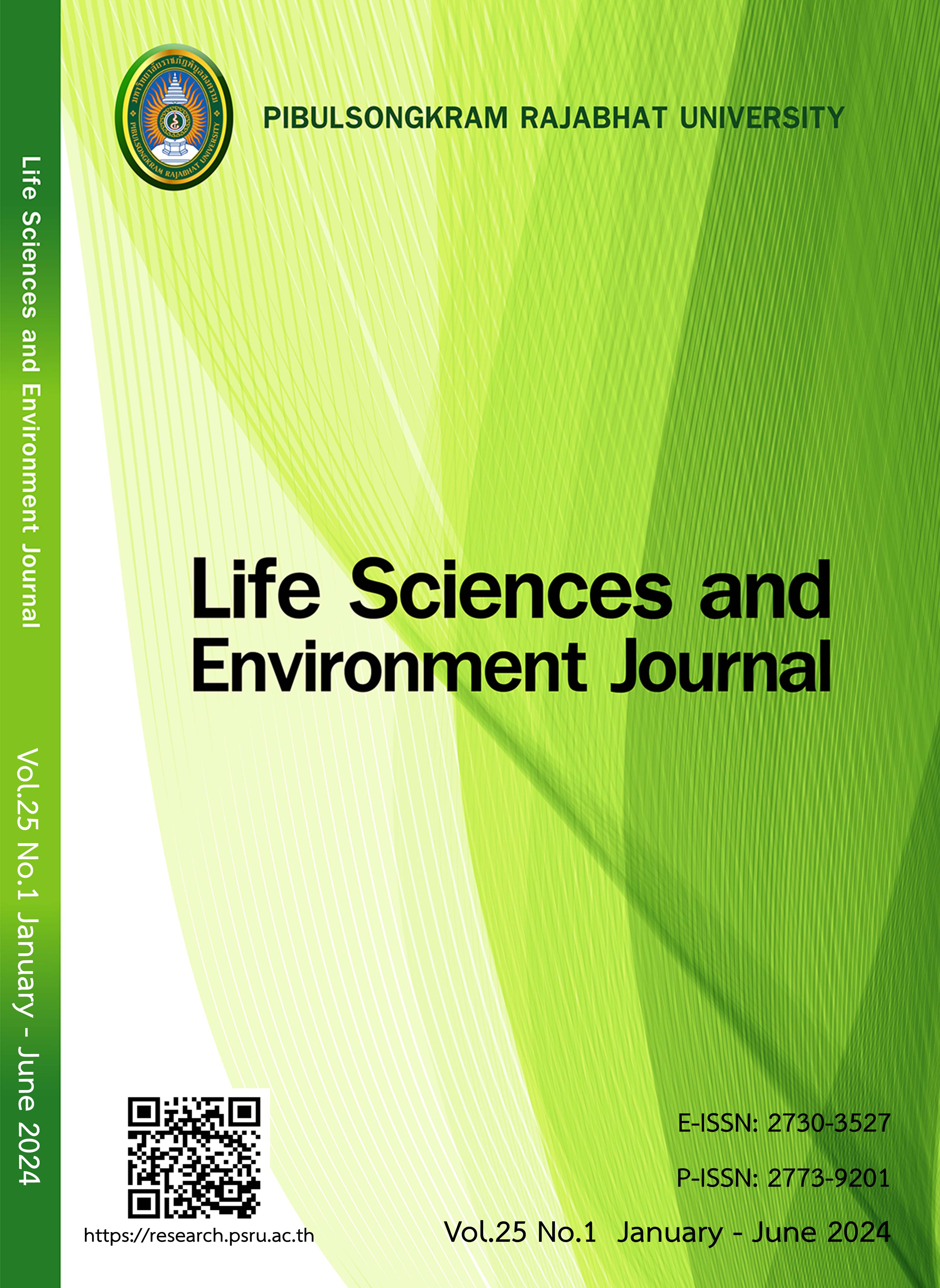APPLICATION OF CARBOXYMETHYL CELLULOSE FROM DURIAN RIND FOR MAINTAINING THE QUALITY OF MANGO FRUITS (MANGIFERA INDICA LINN.) CV. NAMDOKMAI SRI TONG
DOI:
https://doi.org/10.14456/lsej.2024.13Keywords:
carboxymethyl cellulose, durian rind, coating agent, Namdokmai Sri TongAbstract
This research aimed to use etherification to extract carboxymethyl cellulose (CMC) from the rind of durian fruits to coat mango fruits (Mangifera indica Linn.) cv. Namdokmai Sri Tong and maintain their quality. The process involved extracting cellulose in a base and using hydrogen peroxide for bleaching. Monochloroacetic acid (MCA) was used to react with the extracted cellulose. The results found that the suitable conditions for preparing CMC were 20.0 percent sodium hydroxide (NaOH) and 10.0 grams of MCA. The substitution degree (DS) was 0.12.The characteristic analysis of the extracted CMC was identified using a Fourier transform infrared spectroscopy. It was found that the functional group, importantly, corresponds to commercial CMC. The obtained CMC sheet can completely degrade using soil embedding methods within 60 hours. The water vapor permeability (WVP) test results showed that CMC and glycerol affected the film properties. Increasing CMC content, water vapor permeability (WVP) of the film decreased. While increasing the amount of glycerol will cause increased water vapor permeability because glycerol has the property of being a moisture absorbent. The appropriate ratio of CMC and glycerol was 3 %w/v of CMC and the glycerol content was 0.25 %w/v. The prepared CMC can be applied as the mango fruits (Mangifera indica Linn.) cv. Namdokmai Sri Tong coating film to extend the shelf life.
References
Bono A, Ying P, Yan F, Muei C, Sarbatly R, Krishnaiah D. Synthesis and characterization of carboxymethyl cellulose from palm kernel cake. Advances in Natural and Applied Sciences 2009;3(1):5-11.
Elomaa M, Asplund T, Soininen P, Laatikainen R, Peltonen S, Hyvarinen S. Determination of the degree of substitution of acetylated starch by hydrolysis, 1 H NMR and TGA/IR. Carbohydrate Polymers 2004;57:261-267.
Gouhua Z, Ya L, Cuilan F, Min Z, Caiqiong Z, Zongdao C. Water resistance, mechanical properties and biodegradability of methylated cornstarch/poly (vinyl alcohol) blend film. Polymer Degradation and Stability 2006;91(4):703-711.
Ismail N, Bono A, Valintinus A, Nilus S, Chng L. Optimization of reaction conditions for preparing carboxymethyl cellulose. Journal of Applied Sciences 2010;10:2530-2536.
Nuttawadee J, Jurmkwan S, Sutthira S, Suthaphat K. Properties of carboxymethyl cellulose (CMC) film from rice straw pulp. Journal of Science Agricultural 2012;43(3):616-620.
Orawan J, Passakorn P, Chonnikan K, Chanatip C. Extraction and characterization of cellulose from fruit-hulls of durian (Durio zibethinus L.). Faculty of Pharmaceutical Sciences, Burapha University 2017.
Phanomwong, K, Paveechochai S, Dxkmingam A. Studies carboxylic methyl cellulose from water hyacinth to be used as Skin conditioner ingredients. In Research Report. Nonthaburi: Debsirin Nonthaburi school 2018:27.
Rachtanapun P, Luangkamin S, Tanprasert K, Suriyatem R. Carboxymethyl cellulose film from durian rind. LWT. Food Science and Technology 2012;48(1):52-58.
Ragheb A, Abdel T.I, Risayed H, Hebeish A. Preparation and characterization of carboxymethyl cellulose from jute waste. Journal of Fibre and Textile Research 1991;263-269.
Riku A, Harry H, Yrjo H, Kirsi J. Effect of various polyols and polyol contents on physical and mechanical properties of potato starch-based films. Carbohydrate Polymer 2007;67:288-295.
Rudnik E, Briassoulis D. Degradation behaviour of poly (lactic acid) films and fibers in soil under mediterranean field conditions and laboratory simulations testing. Industrial Crops and Products 2011;33(3):648-658.
Singh R, Singh A. Optimization of reaction conditions for preparing carboxymethyl cellulose from corn cobic agricultural waste. Waste and Biomass Valorization 2013;4(1):129-137.
Sothornvit R, Krochta J. Plasticizer effect on mechanical properties of β-lactoglobulin films, Journal of food engineering 2001;50:149-155.
Sumitra P. Isolation of cellulose from some plants and synthesis of its derivatives. Master of Science, Department of Science, Chiangmai University 1980.
Sujitra R, Pornwipa S, Sutjaritpan B. Extraction of CMC from corncob and its application as coating agent on mango fruit. Life Sciences and Environment Journal 2023;24(2):327-337.
Tengrang S, Xenmak P, Liapwan N, Loylert K, Sukhakasem S, Watthanawichit W, et al. Research and development of packing degradable products from agricultural products. In Research and development package report. Bangkok Office of postharvest and product processing research and development, farmers' products, Agriculture 2015:198.
Tharanathan R, Yashoda H, Prabha T. Mango (Mangifera indica L.), "The king of fruits"-an overview. Food Reviews International. 2006;22:95-123.
Tikhamporn C, Benjawan B, Piched A. Carboxymethyl cellulose from corn peel. Kasetsart University, Kamphaengsaen Campus 2019.
Toğrul H, Arslan N. Extending shelf-life of peach and pear by using CMC from sugar beet pulp cellulose as a hydrophilic polymer in emulsions. Food Hydrocolloids 2004;18:215-226.
Downloads
Published
How to Cite
Issue
Section
License
Copyright (c) 2024 Life Sciences and Environment Journal

This work is licensed under a Creative Commons Attribution-NonCommercial-NoDerivatives 4.0 International License.
Each article is copyrighted © by its author(s) and is published under license from the author(s).










